|
History menu >
List of artists and photographers associated with
Malvern in Worcestershire
 Contents Contents
Overview
Artists and photographers
Bates, David
Beaufort, John William
Bennett, Thomas
Brandling, Mary Gifford
Bushnell, William
Down, John
Earl, Francis Charles
Evans, William
Grosvenor, Christopher John
Henley, Samuel
Henley, William
May, Norman
Moody, Catherine
Moody, Victor Hume
Oldmeadow, James Charles
Phipson, Edward Arthur
Steers, Fanny
Stevens, Albert
Stevens, Mrs M
Stowe, Edwin Drury
Taylor, Frederick
Tipping, William
Varley, Illingworth
Varley, Mabel
Walton, Clement David
Webb, Edward
Yeats, George Paterson
Yeats, Nelly Hartnell
Exhibition of Victorian art
References
In March 2016 we came across an index of artists 1790 -
1940 compiled by the Worcester Record Office (ref 1), which contains the
names of several people we had researched and a few we hadn't. Below is a
list of, mostly Victorian, artists and photographers with a connection
to Malvern, together with either information we have gleaned about them, or a pointer
to other material.
Of course hundreds of artists will have visited Malvern
to paint landscapes, and thousands of amateur photographers will have
snapped photos, so what we are presenting here is a glimpse of some of the people
who worked in the town mostly during the days of the water cure. If you feel we
have left someone out please do send us their story so it can be added to
the website. Likewise do let us know if you believe any information is
factually incorrect.
A list of mostly Victorian artists and photographers, ordered by surname.
We came across painter David Bates (1842 - 1921) while researching a mansion named Holly Mount
which stood above the Worcester Road.
The 1881 census recorded painter David Bates living with
his family at Holly Mount Cottage; he is described as an artist, landscape in
oil colour, born March, Cambridgeshire about 1842. This may be the
David
Bates (1840 - 1921) who is listed in the
Dictionary of Victorian Painters (ref 2) thus:
Midlands landscape painter, worked in Birmingham and
Worcester. Exhibited at the RA from 1872, also at SS and GG. Style and
subjects similar to other artists of the Birmingham school, such as Joseph
Thors, and SH Baker. Also made many small oil sketches of hedges and plants,
which he usually inscribed and signed on the reverse.
Earlier in 1873 he had been at Northwick Villa, Northwick Road,
Worcester, then at Mount Pleasant, Henwick Road
before moving to Holly Mount Cottage in 1879. In 1888 he was at Sydenham Villa, Newtown
Road, Malvern.
Kelly's directory of 1884 also listed him as an artist of
Holly Mount Cottage, St Ann's Road. David Bates moves around a lot, and by
1911 he is a Painter and Artist working on his own account at home, living
at Blandford House Teddington; his son David Samuel Bates then aged 34 was an Art Agent.
Click to see some of his paintings on the Art UK website
A painting of Great Malvern Priory, by David Bates, can
be found in Malvern Museum (MM).
In 1889, photographer John William Beaufort (1864 - 1943) was a co-director of the firm Norman May's Studio
in Church Street, Great Malvern (ref 3). He was born at Bradford in 1864, the third son of 'Tinner'
John and Martha Boocock; his mother died soon after he was born and his
father married second, in 1881, Eliza Turner.
The 1881 census recorded John as an artist, living at
home. In 1889 he married Lucy Anne Ostcliffe, the daughter of an innkeeper,
at Bradford Cathedral. At some stage, prior to his marriage, he had
obviously changed his surname, no doubt in order to advance his career. His
marriage certificate confirms that he was a photographer living at Priory
Mount, Malvern.
About 1890, after the death of his co-director Norman May, John went to work
for the famous photographic firm
Elliott and Fry in Birmingham and he became Managing Director from 1915
to 1926.
In 1893 he had joined the Freemasons (St Paul's Lodge,
Birmingham).
John and Lucy Beaufort had two sons, Percival Stanley born at
Malvern in 1890 and Harold Ostcliffe, born at Birmingham in 1894.
During WWI, Percy Stanley Beaufort joined the Artists Rifles as a
Private, and in 1917 was transferred into the Royal Flying Corps as a
communications equipment officer. He survived the war and in 1920 was living
in Birmingham.
Sadly his younger brother 2nd Lt Harold Ostcliffe
Beaufort, 1/6th Battalion, The Prince of Wales’s (North Staffordshire
Regiment) was killed in action on the 13th October 1915 just seven days
short of his 21st birthday. He had attended
Wrekin College
and
another website records his story and that of others who lost their lives in
WWI.
After WWI, John William Beaufort is noted to have painted a
portrait of famous naturalist
Alfred Russell Wallace (1823 - 1913) who was a contemporary of Charles
Darwin. The painting was based on a photograph of Wallace taken in 1903 by
the photographic firm Elliott & Fry; the painting was presented to the
Natural History Museum in 1923,
click to read report in Times.
John William Beaufort, artist and photographer, died at
Weybridge in 1943.
Photographer Thomas Bennett (1824 - 1877) was born at
Ely, Cambridgeshire where his father was a lay clerk of Ely Cathedral. He
married Elizabeth Jane Gray in 1850 and they had eight children.
The 1861 census records the family living at his shop at
46 Foregate, Worcester, where he is described as a Lay Clerk (of the church)
and photographer. His firm Thomas Bennett and Son is thought to have been
established about 1856. His branch in Great Malvern was possibly the second
photographic studio in Great Malvern; the first may have been John Down's, see
below.
In 1873 Thomas was an artist and photographer at 2 Priory
Mount, Church Street and at St Ann's Well and at Foregate Street, Worcester.
Thomas Bennett sadly died in 1877 at 8 Broad Street, aged only 53 years, but the
business was carried on by his wife and children. (for example, see advertisement
on page 57 of Kelly's Directory 1879.)
In 1885 the firm had photographic and art studios at 8
Broad Street Worcester and Gazebo House, Church Street, Great Malvern. In
1888 it was at 8 Broad Street only. Elizabeth died in 1899 and the business
is thought to have been acquired in 1915 by WW Dowty.
Watercolour painter Mary Gifford was born in Devon on
23rd May 1823, the daughter of Charles Gifford and Mary Moresby. She was
reasonably well connected. Her father,
landowner Charles Gifford, lived at Cliff End House, Withycombe Rawleigh; on the 19th
March 1831 he was appointed a Captain in the 1st Devon Yeomanry Cavalry, and
in the 1851 census aged 74, he was recorded as Deputy Lieutenant of the
County of Devon. Mary's mother was born in India.
In 1847, Mary married soldier Herbert Winsloe Patton, the
son of a retired commander in the Royal Navy; the 1851 Post Office directory
records her husband as a Captain, Royal Artillery at Woolwich; sadly he was
a casualty of the Crimean War and died of cholera at sea on board the transport Sydney
at Balaclava, on 27th September 1854.
On 8th January 1856, at Welland, the home of her aunts,
Mary Gifford married second, army officer John James Brandling CB (1821 - 1860)
a Lt Col in the Royal Horse Artillery,
whose brother was MP for Newcastle and came from a wealthy family. He had
served in the Crimea in command of a troop of the Royal Horse Artillery, and
was present at the battles of the Alma, Balaklava, capture of Balaklava, the
siege and fall of Sebastopol, for which he received the medal and clasps,
and the decoration of the Turkish Order of the Medjidie.
The National Probate Calendar records that John
James Brandling died on 16th April
1860 at Woodsley House, Leeds, aged only 39 years, and that his widow, Mary, went to live at
a large house named
Heathlands in Malvern Wells, which may have been owned by
her aunts. Mary had three daughters by her second husband, so one wonders
how she found time to paint scenes of Malvern.
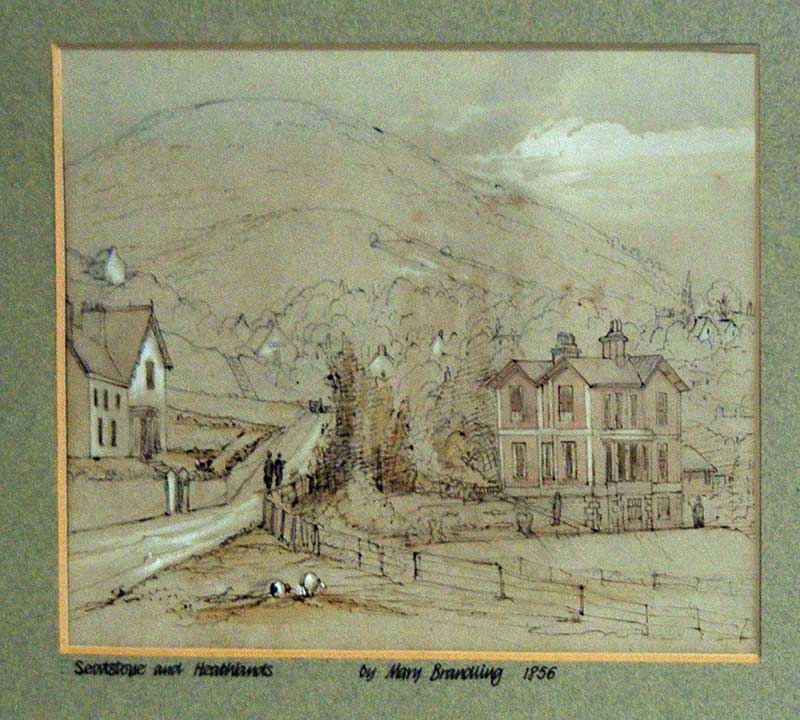
Seatstone and Heathlands, source ML
The National Archives lists a draft agreement dated 1867
between Mary's aunts, Catherine and Jane Moresby, both of Seatstone House, Welland,
spinsters, and Rev Henry Charles Knight
for the sale and purchase for £6,300 of Heathlands House, Welland, with
garden and 8 acres land, together with fixtures and furniture.
Nowadays this
area of Malvern Wells is heavily built upon.
Clergyman Rev Henry Charles Knight (1813 - 1887) MA
Cambridge was in residence at Heathlands in 1871. He was said to be the son of Robert Knight, illegitimate son of the
1st Earl Catherlough, and Frances, daughter of Charles, 8th Baron
Dormer.
In the 1861 census, Mary had been recorded staying with her aunts
Catherine and Jane, at Moresby House, in Malvern Wells. Later the
1871 census recorded Mary visiting the home of Helen Thornhill in
Cheltenham, with her three daughters, where her brother in law was an
artist. In the census, Mary does not describe herself as either an artist or painter, so painting was most likely
regarded as a hobby.
We discovered Mary Brandling had been a watercolour
painter, when we saw examples of her work on display in Great Malvern Priory
during the Autumn Malvern Festival 2016. The
Exhibition of Victorian Art,
showing views of Malvern, was organised by local historian Brian Iles, in
association with Malvern Library (ML), and both are to be congratulated for
organising a well presented, interesting and informative event.
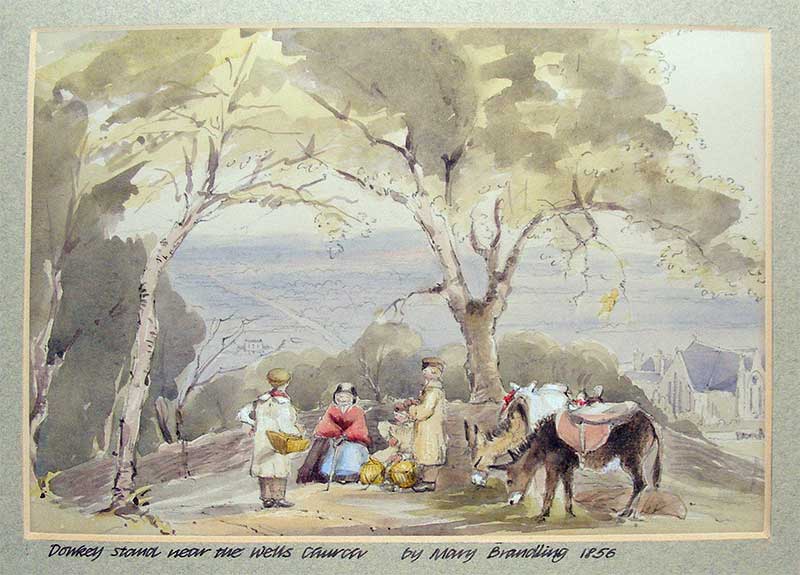
Donkey stand near Malvern Wells' church 1856, source ML
It may have been a factor that her brother in law Henry
Charles Brandling (1826 - 1897) was an artist who has this small entry in the
Dictionary of Victorian Painters:
Brandling, Henry Charles, flourished 1850 - 1881
London painter of genre and portraits. Exhibited 1850 -
1881, at the RA and elsewhere. Titles at RA 'Hier Verkoopt Men Drank' and
'Miss E Brandling' 1850.
He was a friend of the Victorian novelist and playwright,
Wilkie Collins.
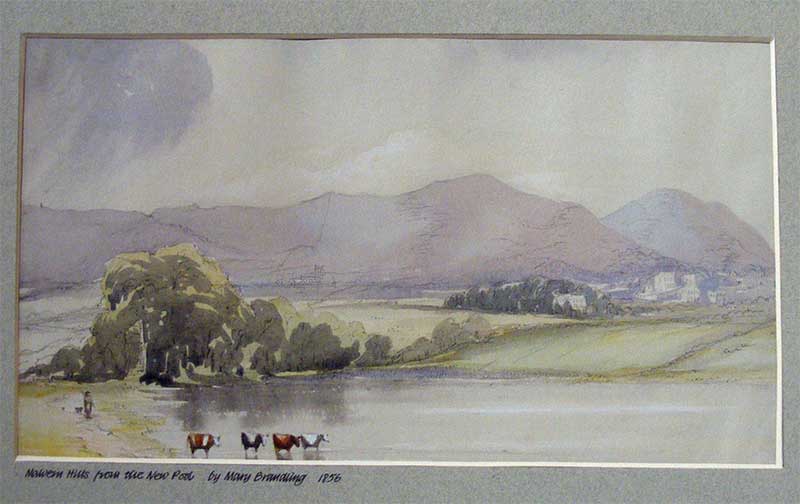
Malvern Hills from the New Pool, by Mary Brandling 1856,
source ML
We thought Mary's painting of a 'Malvern Countrywoman', below,
rather jolly!
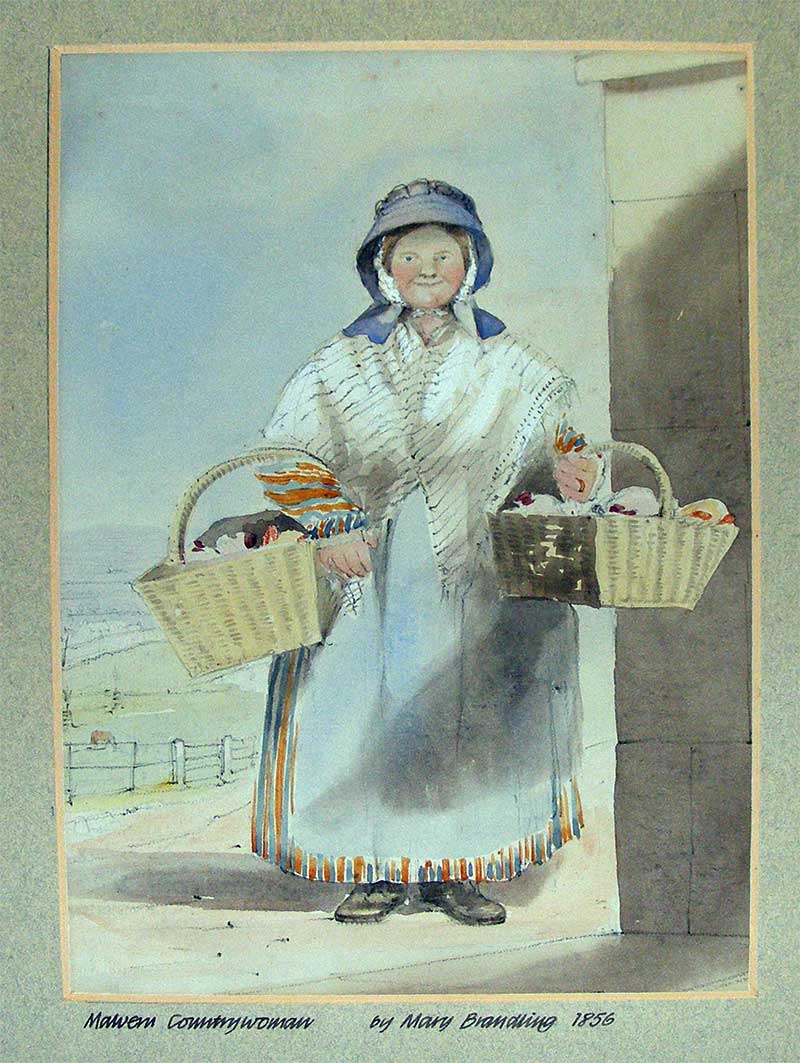
Malvern Countrywoman, Mary Brandling 1856, source ML
Death
The National Probate Calendar records that Mary Brandling
died on 30th May 1873 at Heather Bank, Malvern Wells, and that her executor
was the Right Honourable
Thomas Lyttleton, 4th Baron Lilford, who had married Mary's sister in
law
Emma Elizabeth Brandling - Emma had been painted by
George Frederic Watts,
a noted Victorian artist whose works you can see at the
Watts Gallery
at Compton in Surrey.
Mary Brandling's grave was discovered by the Welland
History Group in 2020 when trees in the old Welland churchyard were
cut back.
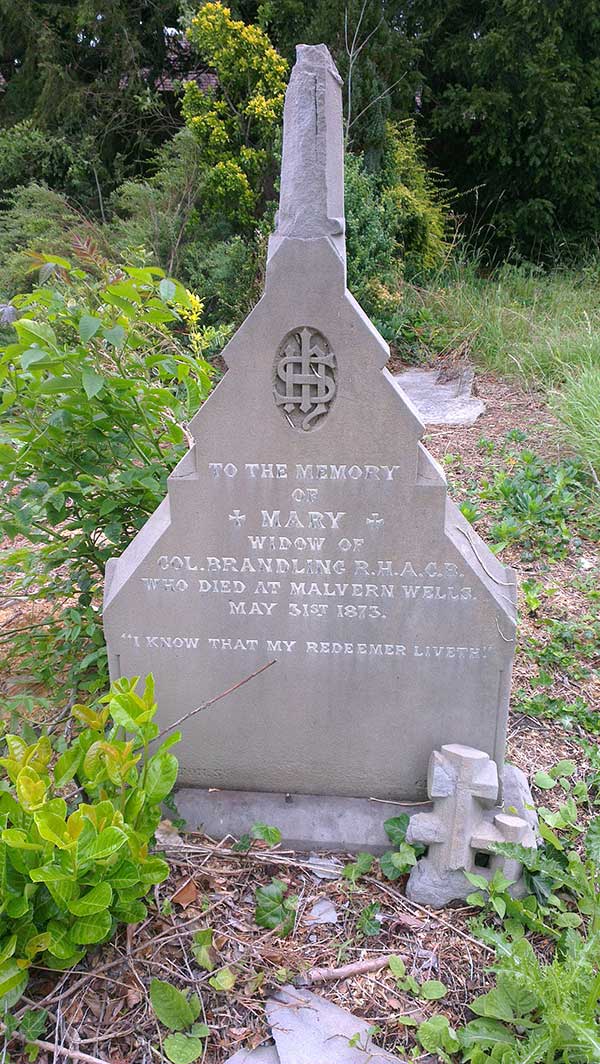 The
inscription on her ornate headstone reads: The
inscription on her ornate headstone reads:
To the memory of Mary
widow of
Col Brandling RHA CB
who died at Malvern Wells
May 31st 1873
I know that my redeemer liveth
Photo opposite: courtesy of the Welland History Group
(click photo to enlarge)
She was aged only 50 years.
Photographer William Bushnell was born in Oxfordshire
about 1856. He established a photographic studio in Bank Street, North
Malvern in a building which once stood on the site of the Nag's Head car
park (ref 4). Trade directories record his studio at Bank Street until 1932.
In 1871 William was working for confectioner Thomas
Hedges in Oxford. Living next door was printer compositor Michael Charles
Aldridge and perhaps it was through him or a contact that William learnt his
trade as a photographer.
In 1879 at St Peter's, Worcester, William married Sarah
Susan Wootton the daughter of builder John Wootton by whom he had three
daughters. Maud Beatrice died aged 9 years and is buried in St Matthias
churchyard in Malvern Link, as are her parents. Mary Sarah and Ethel Jane
emigrated from England to Canada.
The 1881 census records the family living at 8 Lansdowne
Terrace; in 1891 they are at 15 Quest Hills Road and in 1901 at Lansdowne
Place.
Sarah died in 1901 aged 53 years, and in 1903 William
married, second, Ethel Brown, born Norfolk, who had been a cook nearby in Graham
Road. William and Ethel had two sons. In 1911 they were living at 4 Davenham
Cottages in Moorlands Road, within walking distance of William's studio.
Brian Iles book The Malverns contains a lovely photo of a
wedding party in the garden of a black and white cottage in 1910. Brian
comments that William Bushnell had a unique way of posing his subjects in
the picture; some are sitting on the ground and some are standing on chairs.
Photographer William Bushnell died at Malvern in 1935
aged 79 years.
The Post Office directory of 1860 lists John Down, a
photographer, at St Ann's Well, Great Malvern, and some interesting
information about him can be found in Aqua Malvernensis (ref 5).
John was born at Warminster in Wiltshire about 1817
and married Lavinia Rogers at Frome, a few miles to the west, in 1841.
Lavinia was the
daughter of comedian Thomas Rogers. The 1841 census records John Down as an innkeeper, and
residing at the inn was Lavinia's brother Thomas Rogers (junior) also a
comedian. Perhaps this link with Music Hall encouraged John Down to become a
bit of a showman.
By 1851 John and Lavinia had moved to Birmingham where he
is described in the census as an 'artist in wax fruit'. He is said to have
won a prize at the
Great Exhibition of 1851 (ref 5).
John Down moved to Malvern about 1857, where the 1861
census recorded him as an artist living at St Ann's Well, Great Malvern.
Almost certainly it was a commercial decision with the development of
Malvern and the increase of visitors for the water cure for which St Ann's
Well was a focus.
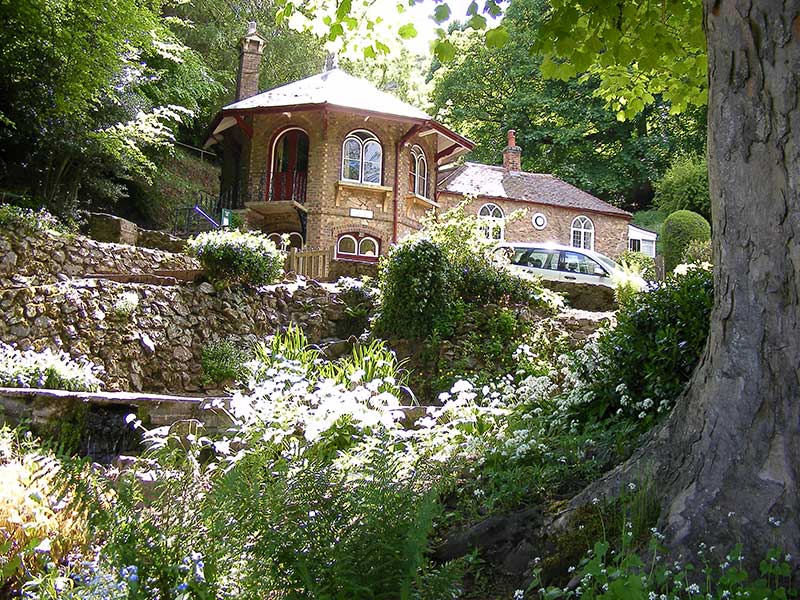
St Ann's Well in 2015
Slaters directory of 1862 listed the firm Down and Co
(photographic) at St Ann's Well.
An old photo in Brian Iles book 'Malvern Through Time'
indicates circa 1870 that John Down's photographic studio was located in an
out-building a few yards below St Ann's Well; it would have stood in the
foreground of the photo above.
Painted in large letters on the side of the out-building,
below the eaves, were the words:
DOWN'S
Photographer
while a large sign at the front of the building read:
Have your family or group taken and don't leave St Ann's
Well without your
carte de visite
John Down also set up a
Camera Obscura
near the Worcestershire Beacon and had earlier constructed a telescope which
customers could pay to look through (ref 5).
Photographer Thomas
Bennett had an adjacent studio within the Octagon of St Ann's Well.
The 1871 census recorded John Down as a photographer of
Rose Villa, Mathon on the other side of the Malvern Hills; with him was his wife Lavinia, daughter Anna a
photographer, artist and colourer, and daughter Mary, a photographer.
Lavinia died in 1876 and in 1877 John Down married,
second, Annie Davies a young lady by whom he had two further children.
In 1881, John Down was still living in Mathon and had
renamed his house 'The Observatory'. His occupation was given as an 'artist
in photography' and with him was his second wife Annie and their son William
aged 2 years. A daughter Annie May was born later that year.
Photographer and entrepreneur John Down died at Malvern in 1887, aged 70
years.
We have been unable to trace what became of any of his
five children.
The Worcester index of artists 1790 - 1940 (ref 1) lists art
photographer Francis Charles Earl (1829 - 1903). His father Francis died
when he was 5 years old, and he was brought up by his grandfather a
shopkeeper in the St John's area of Worcester and an Aunt. The 1851 census
recorded him as a printer compositor.
In 1857 at Worcester he had married Dorcas Millward
Humphreys.
The 1871 census recorded him as an artist living at 46
Broad Street, Worcester.
By 1873 he was a photographer at 46 Broad Street
Worcester and 2 Priory Mount, Church Street, Malvern. In 1885 he was at 46
Broad Street only. See also advertisement opposite page 195 of Kelly's Directory 1879.
A Trade directory of 1880 describes him as a photographic
portraitist, miniature painter, landscape and architectural photographer of
46 Broad Street Worcester and Church Street Malvern. Possibly he employed
Norman May who took over the Studio in Church Street in the late 1870s.
Portraits of the following taken by Francis Charles Earl in the 1860s
are held by the National Portrait Gallery.
-
Georgina Elizabeth Ward (née Moncreiffe), Countess of Dudley,
(1846-1929); daughter of Sir Thomas Moncreiffe; society beauty; second
wife of
1st Earl Dudley who had inherited a great fortune from the coal
and iron industries in the Black Country and purchased Witley
Court from Thomas Foley.
- Benjamin Gibbons (1783 - 1873) Ironmaster and landowner
- Mrs Pearson, relative of the Rector of Great Witley
Another photograph attributed to him is the ruins of
Raglan castle circa 1859.
The 1901 census recorded Francis Charles Earl as a widower
still living in Worcester running a photographic business assisted by his
daughter Mary Dorcas and married son Frank Ferdinand. In 1911, after his
father's death, the census records Frank as a printer at a vinegar works.
Slater's directory of 1862 lists William Evans
(photographic) Worcester Road, Great Malvern.
This was watch and clockmaker William Evans of York
House, next to the White Horse Inn on the Worcester Road. He was born at
Upton Upon Severn about 1811 and is recorded at York House in the 1851 and
1861 census. A trade directory of 1860 records him as a watchmaker and
photographer.
It seems likely he tried his hand at photography, as a
sideline, between roughly 1859 and 1862. He later moved to Lyndhurst in the
New Forest, possibly to be near a married daughter, where he died in 1869.
In July 2017 we were invited to an event at Hampton
House, in College Road, which was recently converted into apartments and is
now known as Magnolia House (ref 17).
Hampton House was once part of Ellerslie school for girls
and on display were a number of photographs loaned by Malvern College, with
which Ellerlsie had merged in 1992. Many of the photos were thought to have been
taken in 1926 and one large print (see below) was faintly embossed in the bottom left
corner:
CJ and E Grosvenor, MALVERN.
The 1901 and 1911 census list Christopher John and Edward
Grosvenor as photographers living in North Malvern, not far from the founder
of Ellerslie, Gladys Sayle.
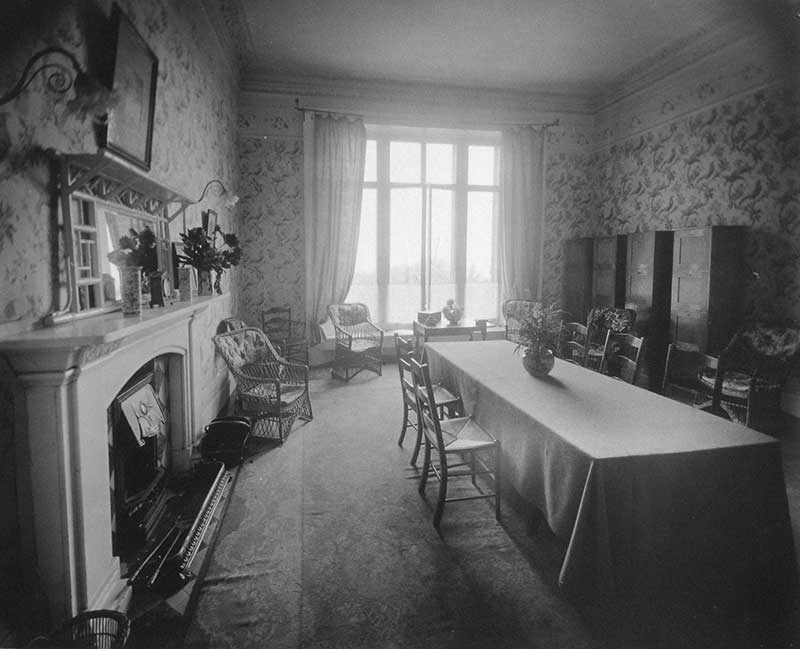
Ellerslie girls' sitting room, 1926, courtesy of Malvern
College
Identical pictures appear in other albums and so we
conclude that the Grosvenor brothers had probably been tasked to provide a
photographic record of the early years of Ellerslie school. Do you know of
any other examples of the brothers' work?
Photographer, Christopher John Grosvenor died two years
later in 1928, aged 58 years.
We have written about artist
Samuel Henley (1794 - 1868) on
another page. He was a Birmingham based accountant who seems to have retired
to the area and taken up landscape painting and drawing following marriage
to his second wife Louisa. Slater's directory of 1861 places him in West
Malvern.
After Samuel died, Louisa became an artist in her own
right and lived at Poolbrook.
We think artist William Bidwell Henley (1823 - 1887) was
the son of Samuel Henley by his first wife Frances T Coward. The 1881 census
records William living at Lansdowne Cottage, Link Common. Kelly's directory
lists him still there in 1884. You can read more about him on our page about
Samuel Henley.
We have written extensively about photographer Norman May who founded
Norman May's Studio in Church Street circa 1879.
Click to go to story of Norman May
Victor Hume Moody (1896 - 1990) was a significant painter
in more recent times. He came to Malvern about 1935 to become Head of the
Malvern School of Art which had come into being about 1886. The building in Victoria Road still has an
art department but is now part of
South
Worcestershire College; click photo below to enlarge.
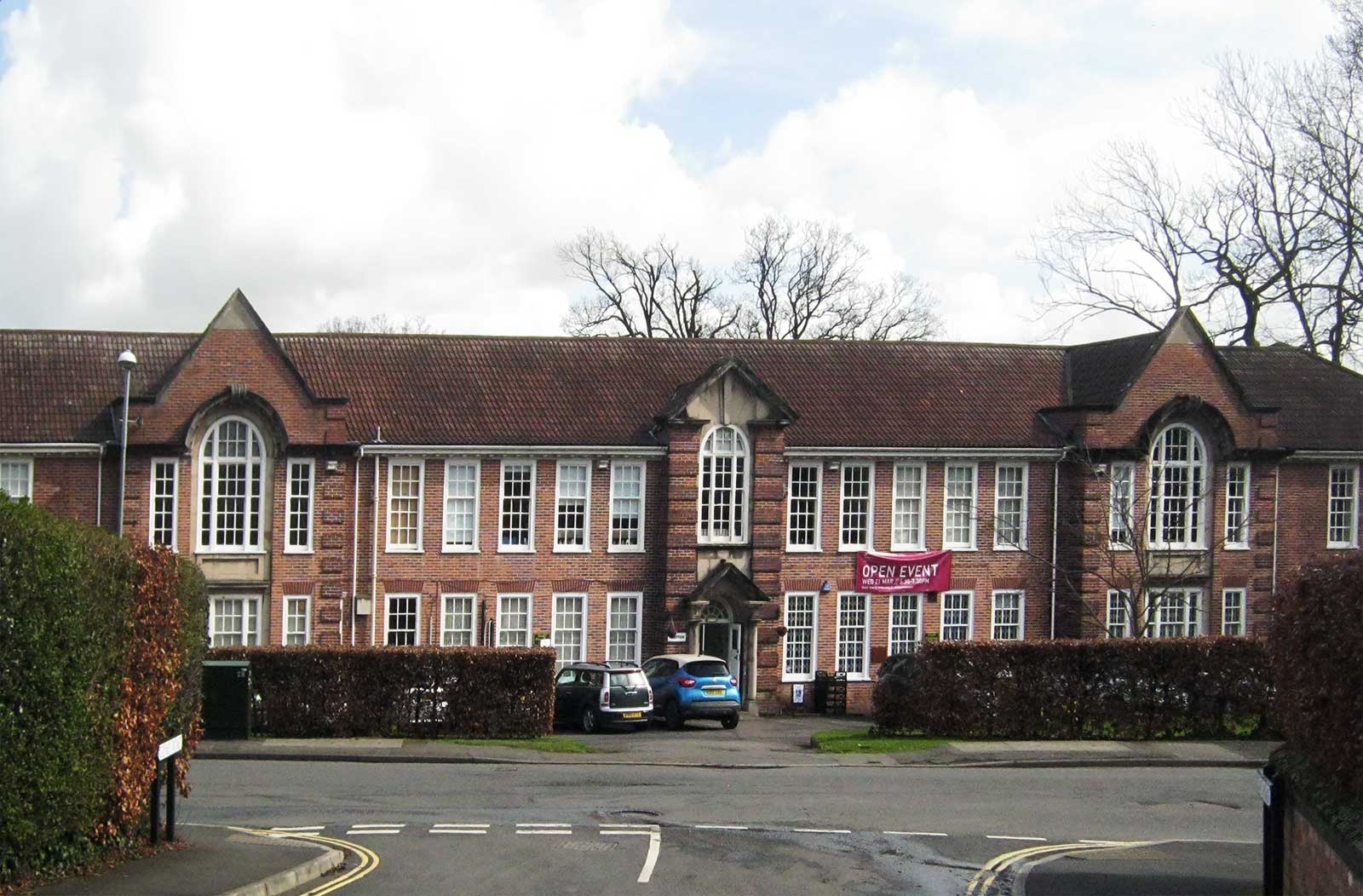
Malvern Hills College formerly the School of Art
Victor Hume Moody was Head of the Malvern School of Art between
1935 and 1962. He and his wife May are buried in the modern section of Great
Malvern cemetery.
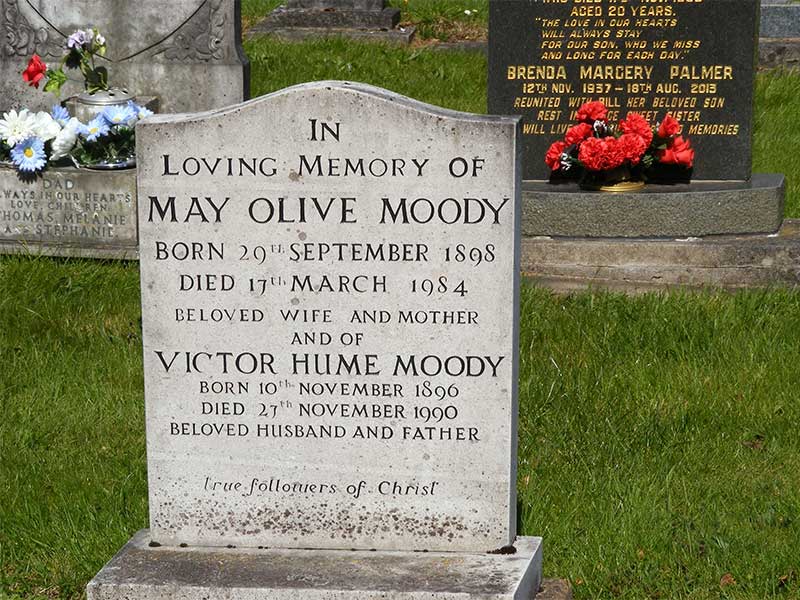
The memorial reads:
In loving memory of May Olive Moody born 29th September 1898, died 17th
March 1984, beloved wife and mother.
and of,
Victor Hume Moody born 10th November 1896, died 27th November 1990,
beloved husband and father.
True followers of Christ
Their daughter
Catherine Moody (1920 - 2009) became a well known Malvern artist and, like her
father, was a President of the Malvern Art Club and head of Malvern School
of Art (1962 - 1980). Her obituary was published in the Priory magazine -
it's worth reading, and you should be able to find a copy on the
Liss Llewellyn Fine
Art website.
Catherine Olive Moody (1920 - 2009) was the daughter of
Victor Hume Moody, see above. You will find her
buried in Great Malvern cemetery not far from her parents.
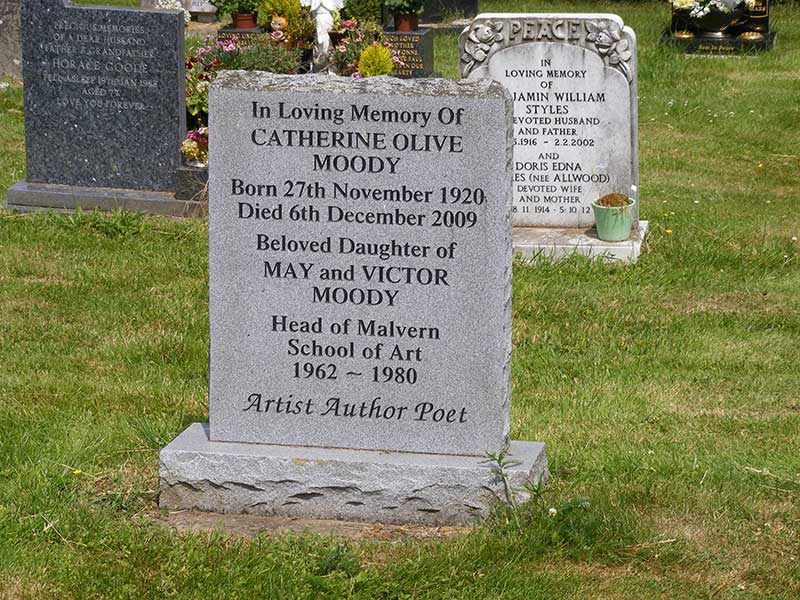 The
inscription on her memorial
reads: The
inscription on her memorial
reads:
In loving memory of Catherine Olive Moody
Born 27th November 1920
Died 6th December 2009
Beloved Daughter of May and Victor Moody
Head of Malvern School of Art 1962 - 1980
Artist, Author, Poet
James Charles Oldmeadow was a Victorian painter who moved
to Malvern from Cheltenham in the late 1850s. In 1868 he was at Abbey Place, Great Malvern
and
in 1873 at 3 Beauchamp Terrace, Worcester
Road, Great Malvern. Described as a professor of drawing, sketching from nature.
Click to go to
story of James Charles Oldmeadow and his family
Edward Arthur Phipson (1854 - 1931), prolific watercolour artist,
and some might say an anarchist, was born in Birmingham and died at Rye in Sussex. His father
Edward was a manufacturer of metallic bedsteads.
Though coming from a prosperous and hard working family,
Phipson does not seem to have been interested in money. His only connection
with Malvern is that his paintings of the Guesten Hall are in the Malvern
Museum. He also painted the Commandery in Worcester.
Two watercolour paintings in the exhibition of Victorian
Art, held at Great Malvern Priory, in October 2016, were by F Steers. We
think the painter may have been Fanny Steers, who seems to
have been quite well known in her day, but strangely does not appear in the
England census.
The first painting (see below) was annotated 'Site of Holy Trinity Church. Domo Villa, by F Steers'. A
typically dour Victorian landscape.
Holy Trinity at Link Top was consecrated in 1851 and
built on land gifted by Lady Emily Foley.
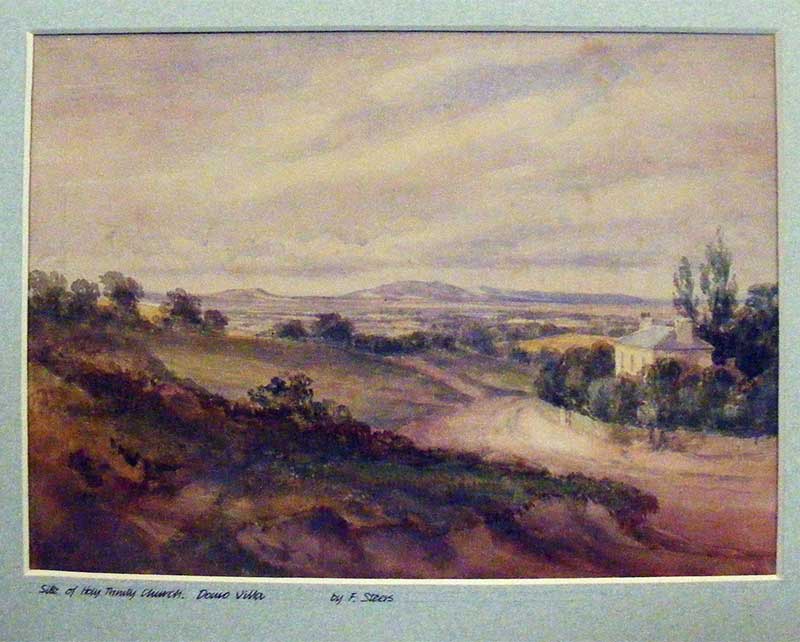
Holy Trinity Church. Domo Villa, by F Steers, source ML
Another painting was an earlier sketch of the Wyche
cutting, dated 1829.
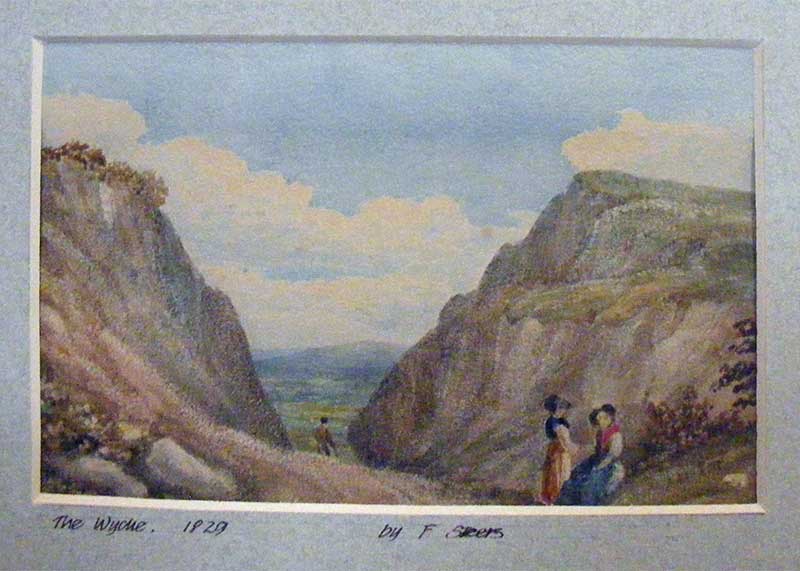
The Wyche, 1829, by F Steers, source ML
Fanny has two entries in the Dictionary of Victorian
Painters:
Steer, Miss Fanny, flourished 1833 -
1842
Painted landscape water colours. Exhibited 25 works at
the Royal Society of British Artists, Suffolk Street, including views in Malvern and on the Malvern Hills. May be the same as
Miss Fanny Steers.
Steers, Miss Fanny, flourished 1846 -
1860, died 1861
London landscape painter, who exhibited 1846 - 1860 at
the New Watercolour Society (59 works), of which she was a member. Also exhibited in Birmingham.
Although Fanny does not appear in the census, her name
frequently crops up in publications.
For example the 'Spectator' Archive, 13th May 1854
reported:
We fix unhesitatingly upon Miss Fanny Steers as the
author of the two best things in the gallery, - 'An Autumn Evening' and 'A
Woodland Scene'; both diminutive. The sweet warm colour, nice observation
and drawing, and tender glow of these little works, are most refreshing.
Miss Steers is a perfect example of modest merit; her productions are always
unconspicuous and delightful, like violets.
Another publication 'The Crayon', correspondence, May
23rd 1855 reported rather verbosely:
A third exhibition just opened is the annual one of the
New Society of Painters in Watercolours. We English say - and as far as I
know surmise, with truth - that we are the first water color painters in the
world. Truly a soothing conviction; but, with all our supremacy, a
water-color exhibition is a tame affair; the work being sovereignly
uninventive and uninteresting, save only as clever transcripts of generally
very ordinary nature from a very ordinary point of view. Landscape 'bit'
after Landscape bit succeeds, diversified by poultry, flowers, interiors,
domesticities, and here and there a subject usually prettified, or
sentimental, or theatrical, or in some other stage of the self-applausive
commonplace. Even more perhaps, than in oil painting, from the comparative
quickness and slightness of the method, each artist gets into a mannerism -
does the same things over and over again, with the same title, the same
color and the same touch. Surely Art, pursued after this fashion, must be a
tedious sort of thing. I don't know that I need particularize more than two
of the contributors - Miss Fanny Steers and Mr Edward G Warren, the son of
the Society's president. The lady has exhibited for several years; but
though the papers generally drop her a civil word, she seems to me never to
have received the kind of recognition which is her due. Her pictures,
always small, and frequently of quite miniature proportions, are, in fact,
some of the most lovely pieces of pure warm color, and heartfelt poetic love
of Nature, that one sees at the present day. There is a glowing richness
about them which seems, so to speak, to have sunk into the paper, and burn
out thence again; a thorough harmony and proportion; and the sure ease of a
mistress of her Art in the representation of whatever she introduces into
her subject. The expender of £7 7s. on Miss Steer's 'Sunset' of this year,
would possess, within the compass of a few inches, the highest Art of the
gallery.
Fanny Steers is also recorded as a composer of melodies
for Victorian songs.
In a small way, she was also an author of, for
example, The Ant Prince a Rhyme, published by
William Pickering, London, in 1847.
Family
Artist and composer, Fanny Steers, was baptised Frances on the 11th
January 1797 at St Mary, Hanley Castle. She was the eldest daughter of
William and Mary Steers later of Rock House, Malvern Wells. Her father had married
second, Mary Smith, at St Brides in London in 1815, and possibly died in
1822.
Fanny's younger sister, spinster Mary Steers (1798 -
1859), seems to have taken over running the family's boarding establishments
adjacent to the Holy Well spring, including the Well House Hotel, after her parents
died, and took legal action against a neighbour attempting to divert water
from the public supply (ref 5).
Youngest sister Elizabeth Steers (1799 - 1876) married
farmer or land agent William Walker, son of William Walker of The Park,
Hanley Castle, and when her sister Mary died, the
couple took over as lodging house keepers at Rock House, where they were at
the time of the 1871 census.
The Park may have been farmland occupying the site of
a mediaeval Deer Park which lay to the west of Hanley Castle church.
After Fanny's sister Elizabeth died, her husband William
Walker continued to live at Rock House with their daughter Louisa who married
retired engineer, Royal Navy, John King. Louisa and John were still at Rock
House in 1891, where she died in 1922.
Fanny Steers, artist and composer, died at Malvern in the
last quarter of 1860. She is buried in Hanley Castle churchyard (ref 16).
Watercolour painter Albert Stevens (1847 - 1934) and his
wife retired
to Malvern about 1924. He was the youngest son of auctioneer John Crace
Stevens (1809 - 1859) and Mary Blockley, who were well known in natural
history circles in their day.
JC Stevens Auction Rooms at 38 King Street London specialised in
selling Natural History artifacts and scientific curiosities.
Between 1848 and 1867, Albert's uncle Samuel Stevens sold
microscope slides of natural history specimens from his Natural History
Agency at 24 Bloomsbury Street, and thereby possibly played a supporting role in
shaping evolutionary theory. Samuel then helped run JC Stevens Auction Rooms until
taken over by Albert's brother Henry who ran the firm until his death in
1925.
Albert's brother John Sanders Stevens became a successful
mechanical engineer as did his sons.
In 1871, Albert was a clerk to the family firm of
auctioneers at 38 King Street, Covent Garden, but in the 1881 census he was
recorded as an Artist Landscape Painter.
Albert Stevens has a short entry in the Dictionary of Victorian Painters
(ref 2):
London landscape painter. Exhibited mainly at the Society
of British Artists and the Royal Academy (1877 - 1902), New Watercolour
Society, Grosvenor Gallery and elsewhere. Titles at RA include English
views; also Switzerland and Italy.
We have not found him in the 1891, 1901 and 1911 census
so perhaps he and his wife were painting abroad. In 1903 they exhibited at
Ernest Brown and Phillips, Leicester Galleries.
An exhibition of water
colour drawings by Mr and Mrs Stevens entitled 'Garden Fantasies and
Landscapes'.
Trade directories indicate that Albert and Mary Stevens
retired to Malvern about 1924 where they set up a studio at The Manse,
Malvern Wells.
The Manse was a large house and there is a photo of it in
Keith Smith's book Around Malvern (ref 11). He records that prior to 1914 the house
had been used as a ladies' school, and is now flats.
Albert Stevens' death in 1934 was mentioned in a column of The Times
(ref 9)
about Art Exhibitions:
Chance brings together three memorial exhibitions ...
At the Graham Gallery, 72 New Bond Street, there are 44
water-colours by Mr Albert Stevens who died this year. Ranging over several
English counties, the Italian lakes, and the Riviera, those are the happiest
with the more intimate kind of natural beauty, as in 'Malvern, the Hills',
'On the Severn', 'The Severn River' and 'Willows'. With more obvious 'views'
Mr Stevens became conventional.
In 1884 Albert had married Mary Jane Ellen Draper (1866 -
1947), who also has an entry in the Dictionary of Victorian Painters:
Stevens, Mrs Albert. flourished 1889 - 1894
(Miss Mary Draper)
Painted animals and landscape. Exhibited five works at
the RA (1889 - 1894) including 'How I Wonder Where You Are' and 'An Alpine
Meadow'. London address.
We think Mary was born at Liverpool, the daughter of Henry Draper who is
described in the 1881 census as a forwarding agent, living at Blundell sands,
Great Crosby. Perhaps Albert had travelled there to paint on the coast.
The couple had one daughter Dorothy Mary Stevens, also an artist, who died at Malvern in
1973.
The Worcester index of artists 1790 - 1940 lists:
May and Stowe, 1879, 37 Tything and Church Street,
Malvern. Advert opposite page 286, Kelly's Directory 1879.
WE
Owens directory of 1880 records:
May and Stowe, photographers, patronized by HRH Prince
of Wales, studio on the ground floor 37 Tything, and Norman May Church
Street Malvern.
In fact the partnership between May and Stowe had been
dissolved the year before. The London Gazette August 29th 1879 (ref 6) reported:
Notice is hereby given that the partnership between
Norman John May and Edwin Drury Stowe at no 37 Tything in the city of
Worcester under the title May and Stowe photographers has been dissolved by
mutual consent.
Dated 16th day of August 1879
Norman John May
Edwin Drury Stowe
Edwin Drury Stowe was an established photographer, 5
years older than Norman May, and perhaps Edwin helped Norman establish the
photographic side of his business.
Edwin Drury Stowe was born in Cheltenham in 1846, the son
of Commission Agent James Stockford Stowe. Trade directories record him
living in High Street Tewkesbury for most of the 1870s, where he is at the
time of the 1871 census.
In 1885 he was a photographer of 8, Castle Street
Cirencester. By 1898 he had moved on again and he and his son Drury, who was
born at Tewkesbury in 1875, were renting premises at 72 High Street Bedford.
The National Archives lists accommodation relating to the
lease of the premises at Bedford, which gives an indication of the extensive
equipment needed to run a photographic business at that time. To quote:
Messuage and shop, with studio, outbuildings and garden
being no 72, High Street, Bedford, now in occupation of Edwin Drury Stowe.
Fixtures, as in schedule
Term - 9 years and 72 days from 1 March 1899
Rent - £130 p.a.
Premises to be kept in repair and painted on outside
every 3rd year and interior twice during said term.
No trade except that similar to present to be carried on
on premises without licence in writing of i) ...... term may cease on 11 May
1901 if 3 months notice given.
Schedule:
Artist Room. Negative rack, shelves etc.
Negative Room. Negative box rack, shelves, bench etc. Copying Room. Camera
Rack. Negative box rack, shelves, painted cabinet etc.
Printing Room. Shelves, frames, high pressure taps etc.
Printing House. "The structure 11 feet 2 inches x 5 feet
6 inches with glass roof, inside table and fittings".
Dark Room - Upstairs. Bench, shelves, galvanised iron
tank, chemical cupboard etc
Dark Room - downstairs. "The Structure with shelves,
sink, gas and water fittings"
Studio. "One radiating stove with flue pipe"
Also mentioned: dressing room, greenhouse, WC under
studio, pantry, wood cupboard under stairs, china cupboard, cellar,
scullery, cellar, kitchen, passage, shop - south window, north window, south
side of shop, dining room, hall, WC; WC in basement, drawing room, back
bedroom, dressing room, stair landing, front bedroom, small front bedroom,
back bedroom, servants bedroom, landing, entrance passage.
Witness Henry Tebbs, solicitor, Bedford Date: 11 March
1899.
Photographer Edwin Drury Stowe died in 1901 aged 55
years; the 1911 census recorded that his son Drury Stowe became a leather
manufacturer.
Fred Taylor (1848 - 1925), born at Worcester, was a teacher of
drawing and painting, working on his own account from home.
In 1884 and at the time of the 1891 census he was living
at 1, Mount Pleasant,
Cowleigh Road, Malvern where he was recorded as an artist and teacher of drawing
and painting.
The 1901 and 1911 census record him living at The Beakes,
a strangely named house containing ten rooms not far from the Unicorn Inn
and Holly Mount; Trade directories record him there until 1916.
If we have it right, Fred married Julia Pardoe, the
daughter of grocer and provisions dealer Joseph Pardoe, in the parish of
Leigh and Bransford on 17th November 1874; the index of marriages recorded him as Frederick Tyler
and we think he may have been the son of boot and shoe maker William Tyler
and Sarah Anne Wells.
Fred Taylor died at Ashley in Malvern Wells in 1925 and
Julia died at Fairholme in Graham Road in 1932. They had six children but,
as far as we know, none of them followed in their father's footsteps.
Sadly eldest son Frederick Joseph Taylor died aged 12 and
is buried in the churchyard of St Peter's, Cowleigh Bank. We have found no
trace of Ernest Frederick born 1878 after 1881 so possibly he died an infant.
Florence Adelaide (1880 - 1945) never married and died at
Hill Mount in Malvern Wells.
Charles Bertram (1883 - 1964), died Truro, became a bank clerk and
married Lucretia Rose Gibbs; they had two sons.
In 1905, Hubert Dunstan (1885 - 1945) married Winifred
Nellie Drinkwater by whom he had a son and daughter and in 1911 the family
emigrated from England to Australia. In 1916 he joined 8th Bn AIF returning
to England. His service record shows he had been a farm labourer, and had
separated from his wife Winifred; in the army he seems often to have got
into trouble and was discharged in England in 1920. He never returned to
Australia and died at Malvern.
Youngest daughter Winifred Mabel (1888 - 1985) married
William Dade at Malvern in 1916; they had 4 children.
You will find that Fred Taylor's children were registered
with the surname Tyler in the district of Martley.
William Tipping was recorded in 1862 and 1870 Trade
directories as a photographer of Newtown, North Malvern. However, we have not
found him in the census and assume he played a minor role in local affairs.
About 1907 Illingworth Varley was appointed Head of
Malvern School of Art. He was there a long time and only retired in
1935 when he was followed by Victor Hume Moody.
To quote from the
Not Just Hockney website:
Illingworth Varley (1869-1942) was born in Saltaire. He
trained at the Saltaire and Shipley Schools of Art, later teaching at both
schools. Between 1893-94 he studied in London at St John’s Wood School of
Art and Hampstead School of Art, where he received various awards and
medals. He then spent three years teaching in Macclesfield School of Art
before returning to London, studying at the Royal College of Art in 1901. He
held several teaching posts in London and in 1907 was appointed Headmaster
of Malvern School of Art, a position he occupied until his
retirement in 1935. Illingworth exhibited work at the Royal Academy and at
other London and regional galleries, including Birmingham and Worcester.
Illingworth has a fleeting mention in the Dictionary of
Victorian Artists.
Varley Illingworth fl 1901
Exhibited a work entitled' Sunshine and Shadows' at the
RA, London address.
His wife Eleanor was also an artist.
Illingworth is buried in
Malvern Wells
Cemetery with his wife and daughters.
Illingworth's daughter Mabel was an Art Mistress at
Malvern St James. Her sister Eleanor became Principal of Lowestoff School of
Art.
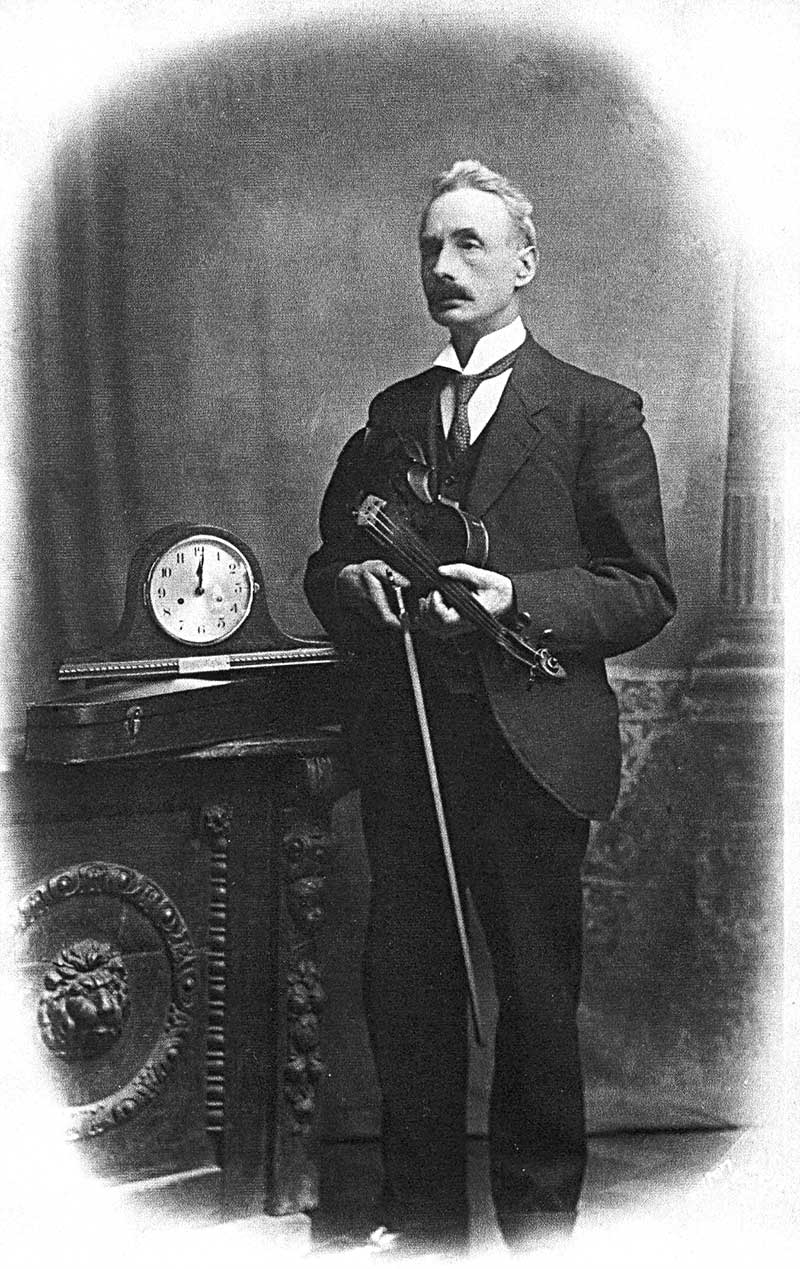 Clem Walton (1875 - 1953) was a well known photographer
of Barnards Green, Malvern and many local photographs bear his name. Clem Walton (1875 - 1953) was a well known photographer
of Barnards Green, Malvern and many local photographs bear his name.
Clem was
born not far from the Malvern Hills at Kinnersley, in Worcestershire; he was the son of tailor Charles Walton who died in 1886 aged
only 45 years, when Clem was 11 years old.
The 1891 census records the family living in Cheltenham
where Clem was a hairdresser's apprentice. By 1901 he was running his own
hairdresser's and tobacconist shop in Barnards Green.
Trade directories
record his hairdresser's business in Court Road, Malvern, from about 1904 to 1940.
He was also a self-taught violinist, see photo opposite
(source: J Tidman).
We were told that the clock on the chest was presented by
'The Men's Own Brotherhood' in the 1930s which it is thought was a group of
the Plymouth
Open
Brethren (ref 13).
Clem was also a member of the Malvern Link,
Phoenix Lodge, branch of
The Royal Antideluvian Order of Buffaloes.
In the photograph below, taken in 1924, he is second from right in the
middle row (click photo to enlarge).
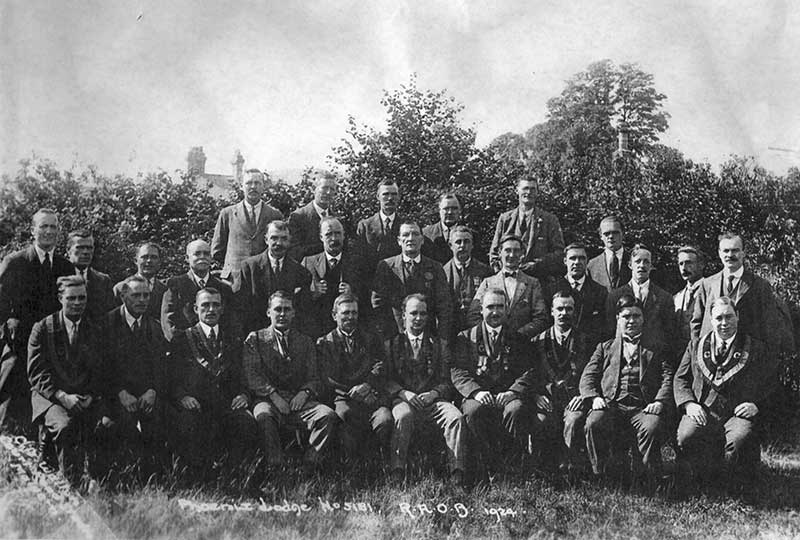
Phoenix Lodge No 5181 RAOB 1924 (source: J Tidman)
The inscription at the bottom left of the image is faded
now, but it appears to read:
CD Walton, Court Road Studio, Malvern
On the 1911 census form, Clem described himself as a
hairdresser and photographer living at a house named Balstonia on the corner
of Pound Bank and Wedderburn Road, not far from
John Henry Tandy who sadly would be killed in the Great War.
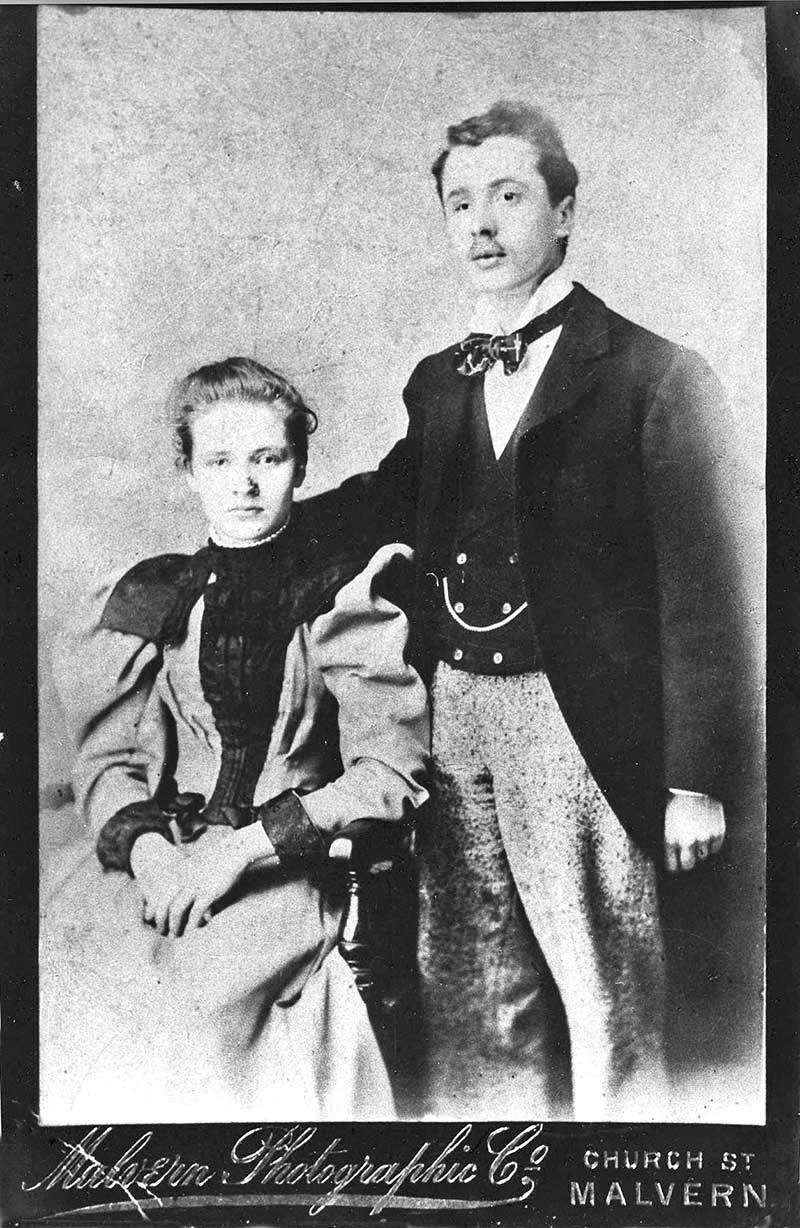 In
1899 Clem had married Kathleen Eliza Ann Cowley, and the couple went on to
have seven daughters. In
1899 Clem had married Kathleen Eliza Ann Cowley, and the couple went on to
have seven daughters.
A wedding photo, shown opposite, (source: J Tidman) bears
the legend, Malvern Photographic Co, Church Street. A Trade directory of
1880 lists Malvern Photographic but not who was running it; if you
know, do please tell us.
In 1918 Clem served with the RAF. It is said at some stage
he lost the sight in one eye. Fortunately he survived WWI. His RAF service
papers recorded his religious denomination as Plymouth Brethren. In those
days the Brethren met at the Gospel Chapel at Hall Green, locally known as
the Tin Tabernacle which is mentioned in the Guarlford Story (ref 14).
People say Clem was often seen on his bicycle with
equipment on the back; he seems mostly to have taken photographs of groups
of people, rather than landscapes and buildings. For example see the school
photograph below (click to enlarge):
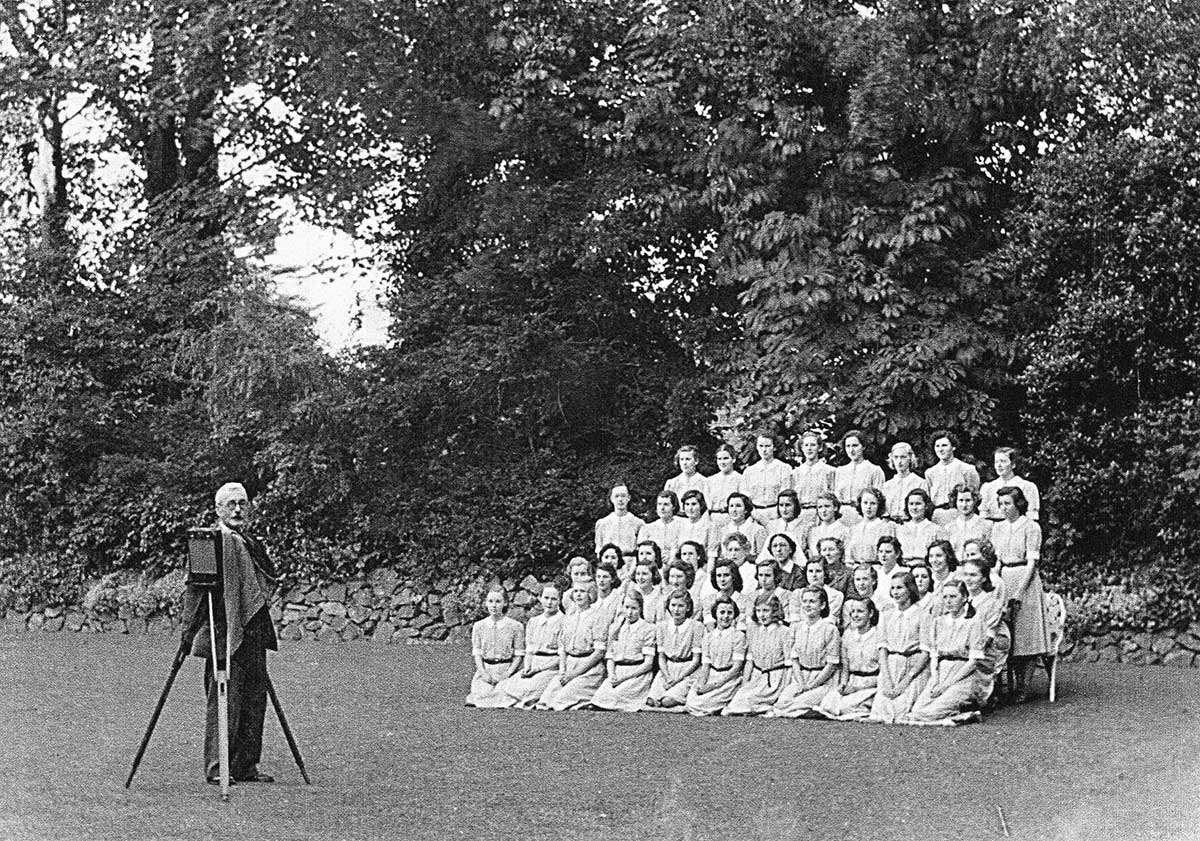
CD Walton working at Malvern Girls College (source: J
Tidman)
Another of his photographs, below, now forms the cover of 'The
Guarlford Scene' published by the Guarlford History Group. This wonderful photo, which
had some damage, was given to us by our friend the late Derrick Bladder who lived on the
Guarlford Road.
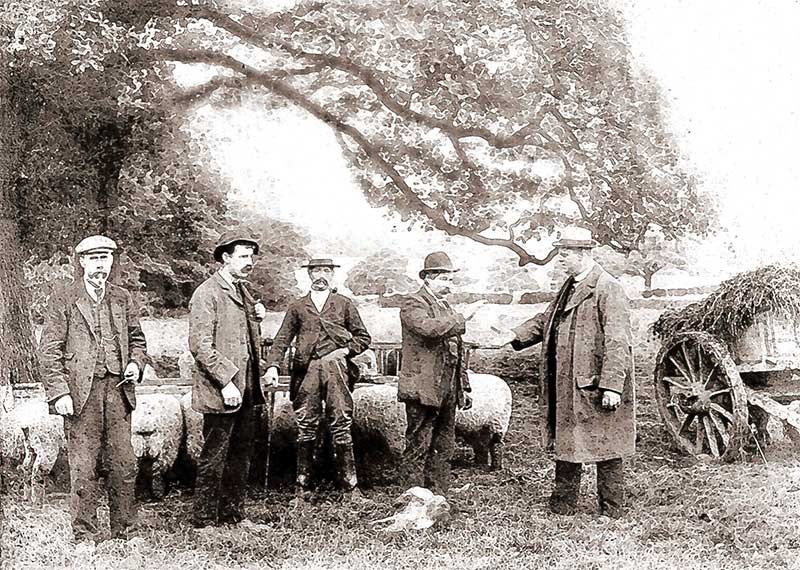
Derrick Bladder's grandfather striking a deal
Photo by CD Walton, restored by Michael Skinner
Edward Webb (1805 - 1854) was a landscape watercolour
painter and steel engraver who, for reasons unknown to us, is buried in the
churchyard of Great Malvern Priory. He studied under the engraver
John Pye
and later with
Copley Fielding and
David Cox RWS, the elder, (1783-1859) a famous member of the Birmingham School of Landscape Painters.
Edward made many English and French tours, and visited Scotland in 1834 and Wales in 1837 and 1840 with David
Cox's son who was also a painter. The son also named David Cox AWRS (1809 -
1885) studied under his father and often imitated his style.
Few people today will have heard of Edward Webb, but some
may have come across his son, Sir Aston Webb, the famous architect, who
designed Admiralty Arch in London and the Victoria Law Courts in Birmingham.
The photograph below shows Edward Webb's memorial topped
by a cross.
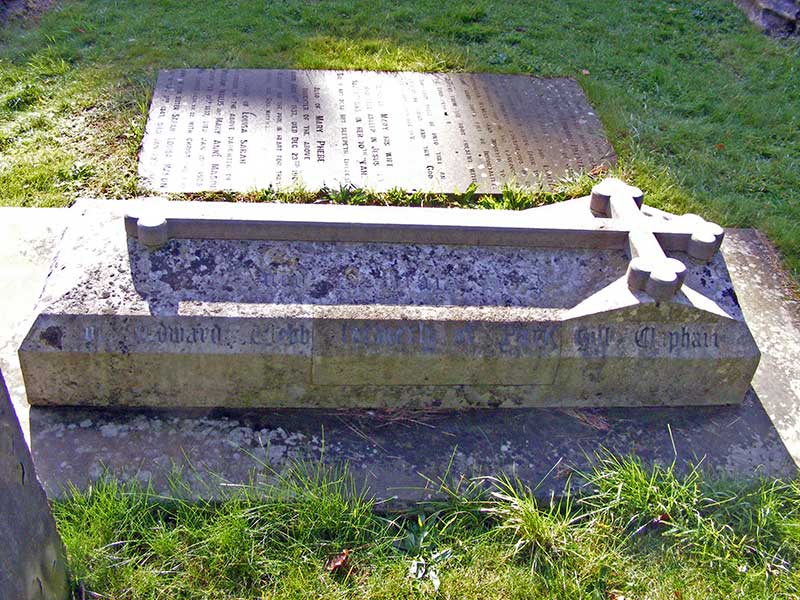
The inscription on the top of the tomb is very worn now, but reads on one side:
Edward Webb who died 9th October 1854 aged 49 years
The other side reads:
Edward Webb of Park Hill House, Clapham, Surrey
At the foot of the tomb has been added:
In memory
Father of Sir Aston Webb PRA who died August 21st 1930
and E Alfred Webb FSA who died July 23rd 1939
See photo below.
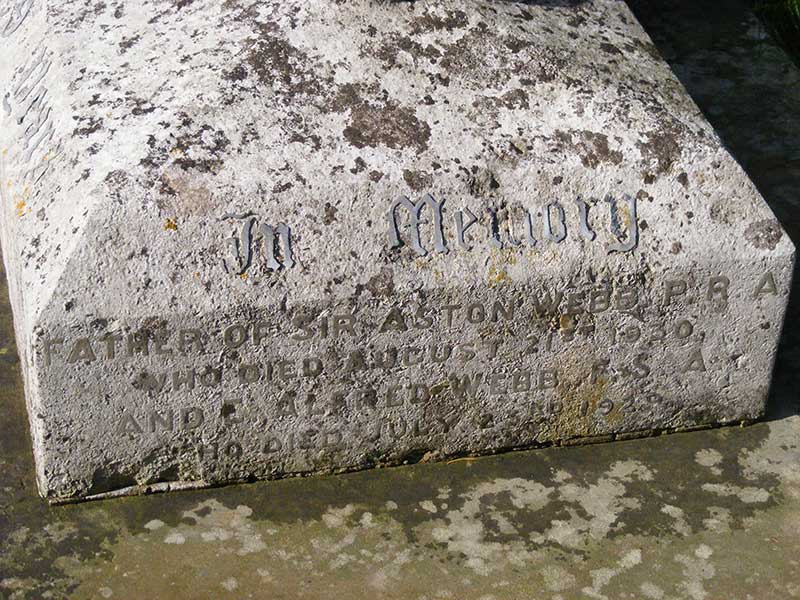
Edward was the son of Charles Tarr Webb (1774-1849) and
Ann Aston. His father Charles is recorded as a Gold Lace maker of 48
Picadilly in the parish of St James, Westminster. It seems likely his
business was concerned with embellishing military uniforms.
Edward Webb's brother John was an eminent collector of fine art and an
adviser to the Victoria and Albert museum. His obituary was published in the
London Times on 21st June 1880.
Perhaps it is not surprising, given this background, that Edward became a
landscape painter.
In 1844 Edward married Anna Evans, daughter of drug
merchant John Evans at St Bartholomew's in London. Sadly not long after Anna died at
Versailles in France on 17th October 1850.
Edward and Anna's two surviving sons were
Aston Webb
who become a famous architect and his brother Edward Alfred Webb who wrote a
history of St
Bartholomew's
and is listed in the census as a wholesale druggist. Nowadays he might be described as a 'pharmaceutical supplier'. Aston Webb was elected President of the
Royal Academy 1919-1924. His many designs included
Admiralty Arch and the
Victoria Law Courts in Birmingham. The initials after the name of his
brother Edward Alfred Webb suggest he was a Fellow of the Society of
Apothecaries.
George Paterson Yeats, born Aberdeenshire, Scotland, about
1823, was an author, artist, and teacher of drawing and painting. In 1855 he
married Mary Ann Hartwell Bird in Worcestershire, and they went on to have 7
children.
In 1861 he was living at Upper Swinford, Stourbridge, and described as
Master of School of Arts; in 1871 he was still in Worcestershire and described as
an Art Teacher. His watercolour paintings are detailed and provide a lovely
glimpse of bygone Malvern.
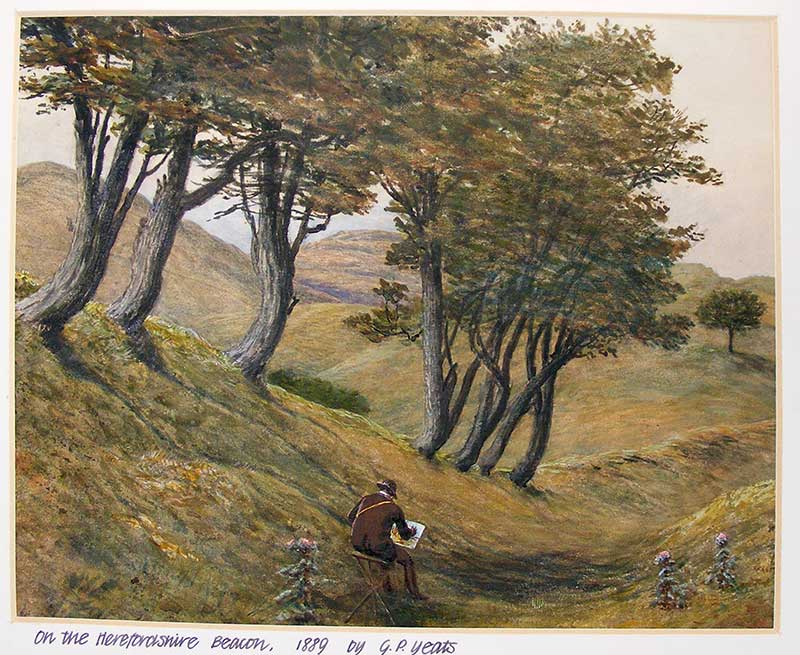
On the Herefordshire Beacon, 1889, by GP Yeats, source
ML
We like to imagine that Yeats has painted himself into
the picture above.
By 1881 he was living in Priory Road, Great Malvern, when
his daughter Nelly was described as a flower painter. Just above Priory Road
is Grange Road, which is pictured below.
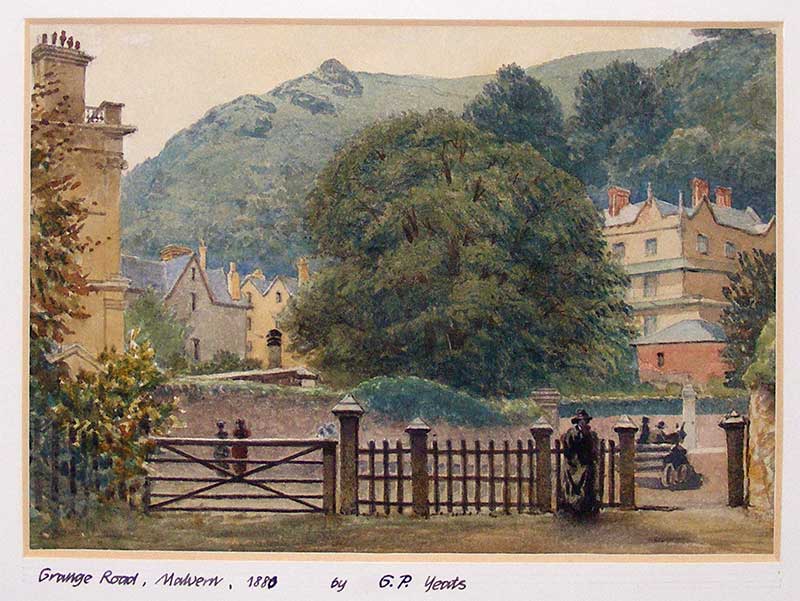
Grange Road, Malvern, 1880 by GP Yeats, source ML
George and Mary's eldest son Joseph Ralph Raeburn Yeats
became an engineer and emigrated from England to Australia. An Adelaide
newspaper reported that on 26th November 1887 Joseph Ralph Raeburn Yeats
married Alice Bertha Barker of Buxton Road, Adelaide. To quote:
South Australian Register, Adelaide, Tue 29 Nov 1887,
Family Notice
YEATS—BARKER
On the 26th November, at the residence of the bride's
parents, by the Rev Samuel Hebditch, Joseph Ralph Raeburn, eldest son of
George Patterson Yeats, Esq, of Kildare, Worcestershire, England, to Alice
Bertha, second daughter of James Barker Esq, Buxton Street, North Adelaide.
In 1875 Joseph had been apprenticed into the merchant navy,
but deserted in San Francisco in 1877; that may explain why Joseph had been
in HM Prison Holloway in 1881.
Joseph and Alice's eldest son was born at Broken Hill in
1888, soon after the discovery of silver and the formation of the Broken
Hill Mining Company.
Back in the UK, about 1889 George and his remaining
family moved to a house named Kildare in
Manby Road. George's wife Mary is then described as a Superintendent of a Home. Also in
the household were:
-
James G Howell, a visitor, clergyman without a
benefice, aged 61
-
Edward H Robson, a patient, also a clergyman aged 64
-
Elizabeth Tudge, a patient, aged only 26, living on
own means
together with a housemaid, nurse, cook and kitchen-maid.
The 1911 census records mechanical engineer William
Parker-Brough living at Kildare who is strangely described as a motor owner.
His wife Laura Westbrooke Squires had been born in Adelaide, South
Australia. Their marriage was reported in an Adelaide newspaper:
Miss Laura Westbrooke Squires, second daughter of Mr
William Herbert Squires, late of Adelaide, was married on July 31 1894 at St
George's, Hanover Square, to Mr William Parker Brough, son of Mr William
Bromfield Brough, of Enderley, Bromley, Kent, late of Alexandria, Egypt.
'Kildare' was not large by Malvern standards having only
8 rooms.
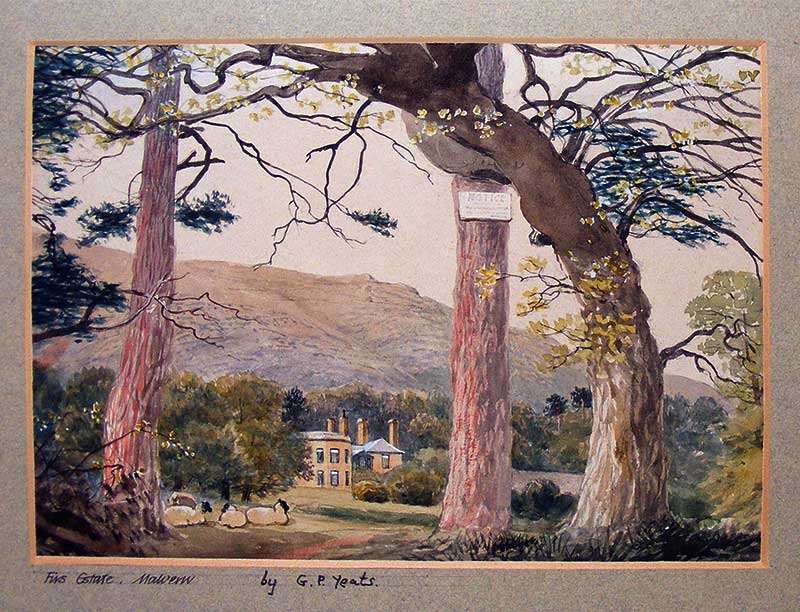
The Firs Estate, Malvern, by GP Yeats, source ML
We think the picture shown above relates to a piece of
ground to the south of Malvern College on the edge of Peachfield Common.
George Paterson Yeats is said to have published a book in 1884, The London
Obelisk: a new translation of the hieroglyphic text; and another,
Observations on the earthquake of December 17th, 1896 which was observed in
Herefordshire and caused some damage to buildings.
Artist George Paterson Yeats died in 1901 when the family was
living at Landsowne House in Madresfield Road. He is said to be buried in
Great Malvern cemetery.
The 1911 census records that youngest son George Malcolm
Yeats (1869 - 1945) went on to become managing director of a refrigeration
company. He may have painted as a young man, as the picture below was
exhibited with his father's work, showing the railway bridge on Link Common.
This lacks the quality of his father's work.
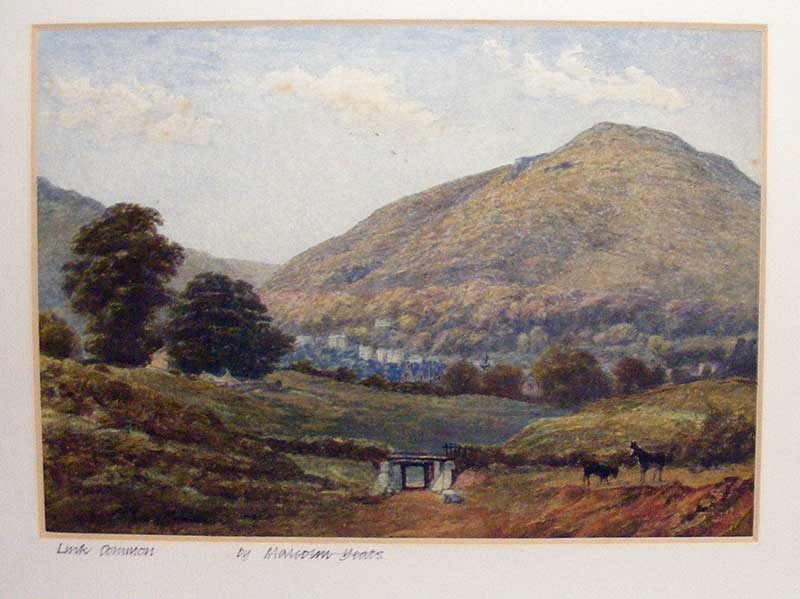
Link Common, by Malcolm Yeats, source ML
George's youngest daughter has a brief entry in the
Dictionary of Victorian Painters.
Yeats, Miss Nelly H
Exhibited 'Roses' at the RA. Address in Malvern, Worcestershire.
It seems probable that Nelly was taught by her father, and
occupied herself by painting at home.
When her father died, her mother Mary took in boarders at
Lansdowne House, which had 15 rooms, and when Mary died in 1908, Nelly in
turn became a Boarding House Keeper; she may have continued to paint in her
spare time.
Nelly Hartnell Yeats, painter, born 1866 died at Malvern
in 1927.
What of Nelly's other brothers and sisters?
David Osborne Yeats sadly died in 1874 aged only 14
years. Fanny emigrated from England to Australia where she married Albert
Sharp in 1887. Harriet Spencer Yeats married Thomas Alexander Garrett; in
1911 they were living in Reigate when he described himself as an
experimental physicist (shipping). As mentioned above, Nelly's youngest brother George Malcolm
Yeats became a director of a refrigeration company.
Click
to view a 'Virtual Gallery' of other paintings by George Paterson Yeats,
from the Malvern Library collection
In October 2016 an exhibition of Victorian Art, showing views of
Malvern, was organised by local historian Brian Iles, in association with
Malvern Library. This was part of the wonderful Autumn in Malvern Festival
event, organised by Peter Smith.
The exhibition was held in the north aisle of Great
Malvern Priory and you will see we have included 'snapshots' of some of the
pictures from the Malvern Library (ML) collection to illustrate this
page. We hope that if you are interested to find out more, you will contact Malvern
Library.
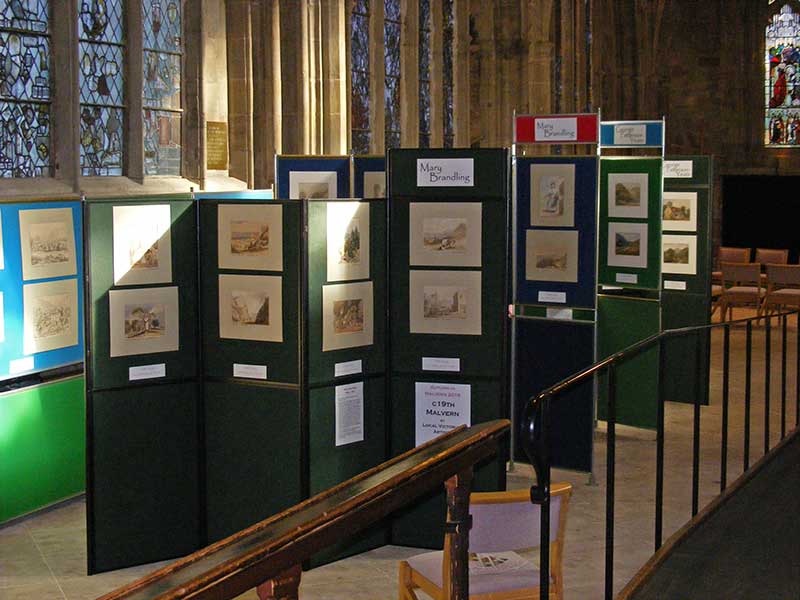
This exhibition was mainly devoted to watercolours by
Mary
Brandling and George Paterson Yeats, but there were a few other works, for
example a view of Jubilee Drive by P Scott Russell - we have been unable to
determine who Scott Russell was - can you tell us?
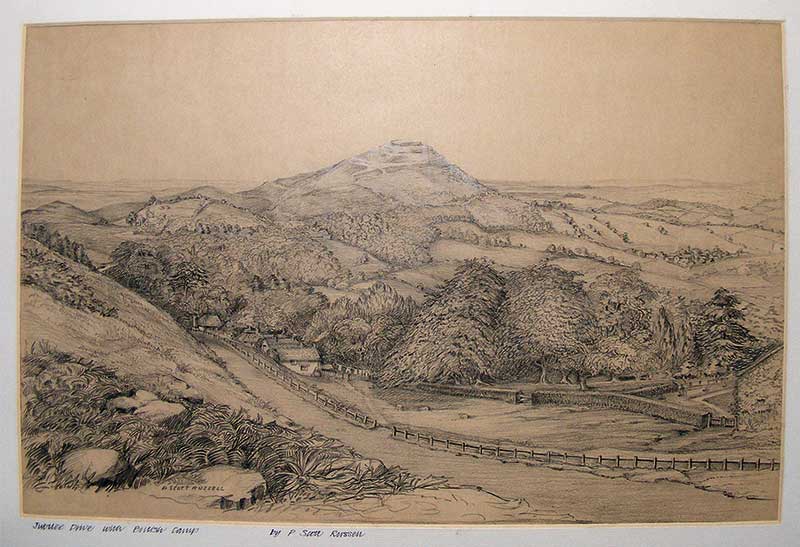
Jubilee Drive, British Camp, by P Scott Russell, source ML
Another lovely drawing was a sketch of Great Malvern
looking northwest towards the Abbey Gateway.
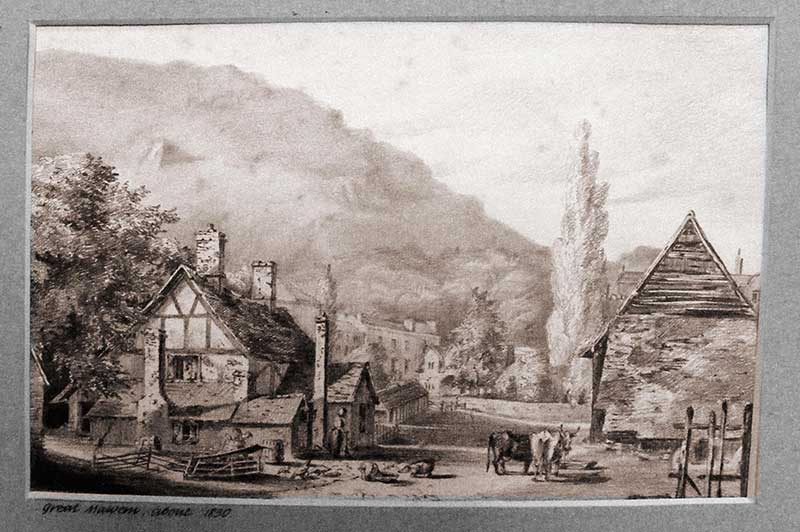
Great Malvern about 1830, artist unknown, source ML
Brian Iles and Malvern Library are to be congratulated for
organising an excellent event.
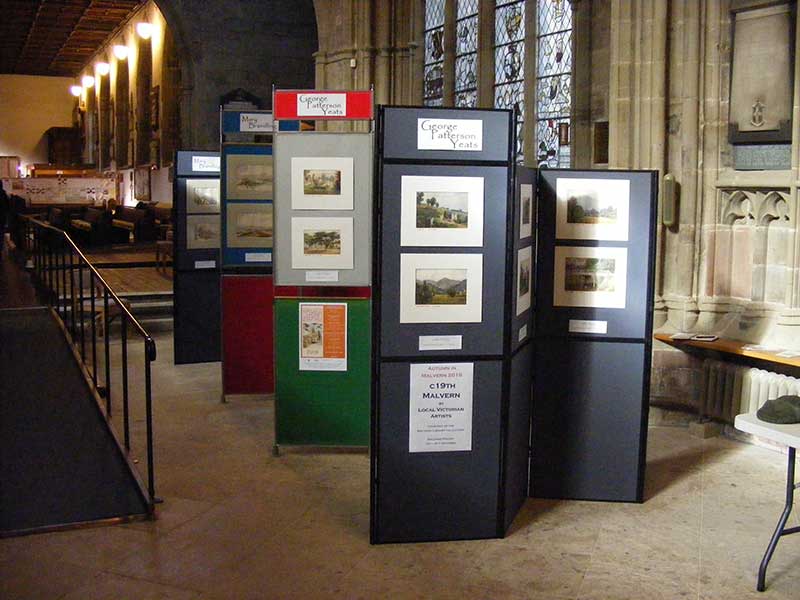
Art exhibition in Great Malvern Priory, October 2016
BBC Your Paintings and the Art UK website
We found the BBC website 'Your Paintings' a valuable
source of information about works of art, but circa 2015 it was
replaced by the Art UK website
artuk.org
Art UK say their mission is to open up public collections
for enjoyment, learning and research. It encourages public collections to show
their artworks online, including works in storage that are not usually on
view.
Art UK is a registered charity (previously known as the
Public Catalogue Foundation). The website is a joint initiative between Art
UK and art collections from across the UK. Project partners include the BBC,
Oxford University Press, the Public Monuments and Sculpture Association,
Culture 24, the Visual Geometry Group at Oxford University and the
University of Glasgow. Mostly the pictures are oil paintings.
In some cases you will find a short biography of the
artist, but often you will not.
Malvern Library
The Art UK website says this about Malvern Library:
Malvern Library holds an extensive collection of
illustrations of Malvern and the surrounding area. This includes oil
paintings, watercolours, photographs and lithographs. Many benefactors have
donated items to the collection since the library was opened over 100 years
ago. One of the highlights of the collection is a painting of Great Malvern
by William Turner of Oxford (1789–1862) presented by Sir Edward Elgar in
commemoration of the passing of the Malvern Hills Act 1924.
We assume most of these works of art are held in a
storeroom, though items from the collection are regularly put on display.
Malvern Library has an 'Additions to Stock' book going back to the early
days of the library with details of all the donors. Items from the
'Illustrations' collection in the Library are available on request (ref 16).
- Worcester Artists 1790 - 1940, Index, Worcester Records Office
- Woods Christopher, Dictionary of British Art Vol IV, Victorian
Painters, published 1995. Volume 1, 'The Text' ISBN 1 851491716
- Obituary of Norman May, Malvern Advertiser, June 22nd 1889
- Iles Brian, Malvern Through Time, Amberley Publishing, 2009
- Weaver Cora, Osborne Bruce, Aqua Malvernensis, the Springs and
Fountains of the Malvern Hills, Aldine Press 1994
- London Gazette August 29th 1879
- England and Wales Census
- Kelly's and other Trade Directories of Worcestershire
- The Times 1934
- Wikipedia
- Smith Keith, The Archive Photographic Series, Around Malvern,
Chalford Publishing 1995
- Indexes of births, marriages and deaths
- Communication from J Tidman, May 2016, grand-daughter of CD Walton
- The Guarlford Story, published by the Guarlford History Group 2005
- Exhibition of Victorian paintings at Great Malvern Priory, October
2016
- Communication from C Lees, Malvern Library
- Promotion organised by Philip Laney and Jolly
- Communication from Welland History Group, June 2020

Back to top
|

 Contents
Contents








 The
inscription on her memorial
reads:
The
inscription on her memorial
reads:

 Clem Walton (1875 - 1953) was a well known photographer
of Barnards Green, Malvern and many local photographs bear his name.
Clem Walton (1875 - 1953) was a well known photographer
of Barnards Green, Malvern and many local photographs bear his name.
 In
1899 Clem had married Kathleen Eliza Ann Cowley, and the couple went on to
have seven daughters.
In
1899 Clem had married Kathleen Eliza Ann Cowley, and the couple went on to
have seven daughters.










